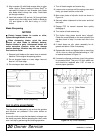
20 Owner Service
MAN0670 (11/16/2007)
3. Align crossbar (8) with blade access hole in cutter
frame. Apply a liberal coating of Never Seez
®
or
equivalent to blade pin and crossbar hole. Make
sure blade offset is away from cutter. Push blade
pin through crossbar.
4. Insert lock washer (15) and nut (14) through blade
access hole in the cutter frame. Install on blade pin
(12) and tighten to 450 lbs-ft using a 1-11/16"
socket.
Blade Sharpening
NOTICE
Closely inspect blades for cracks or nicks,
replace damaged blades in sets.
When sharpening blades, grind the same
amount on each blade to maintain balance.
Replace blades in pairs. Unbalanced blades will
cause excessive vibration, which can damage
gearbox bearings. Vibration may also cause struc-
tural cracks to cutter.
1. Sharpen both blades at the same time to maintain
balance. Follow original sharpening pattern.
2. Do not sharpen blade to a razor edge—leave at
least a 1/16" blunt edge.
3. Do not sharpen back side of blade.
Figure 13. Blade Sharpening
SLIP CLUTCH ADJUSTMENT
The slip clutch is designed to slip so that the gearbox
and driveline are protected if the cutter strikes an
obstruction.
A new slip clutch or one that has been in storage over
the winter may seize. Before operating the cutter, make
sure it will slip by performing the following operation:
1. Turn off tractor engine and remove key.
2. Loosen nuts on springs until the springs can rotate
freely, yet remain secure on the bolts.
3. Mark outer plates of slip-disc clutch as shown in
Figure 14.
4. Securely attach implement to the tractor and start
the tractor.
5. Engage PTO for several seconds then quickly
disengage it.
6. Turn tractor off and remove key.
7. The friction lining plates should have "slipped".
Check the marks placed on the outer plates of the
slip-disc clutch in step 3 to make sure this is the
case.
8. If clutch does not slip, check assembly for oil,
grease and debris. Clean if necessary.
9. Reassemble clutch and tighten bolts no more than
1/8 of a turn at a time until desired setting of 1.26"
is reached as shown in Figure 14.
10. If excessive slippage continues, check lining plates
for excessive wear. They are 1/8" thick when new
and should be replaced after 1/32" of wear to
ensure proper operation.
Figure 14. Slip Clutch Assembly


















